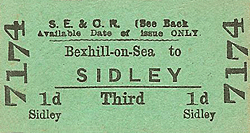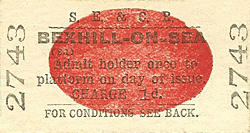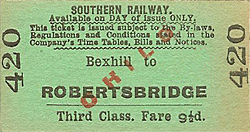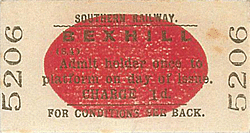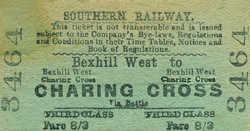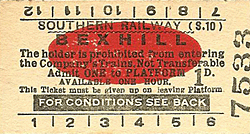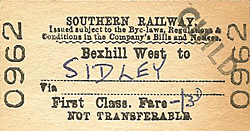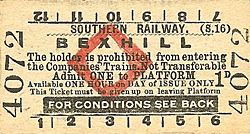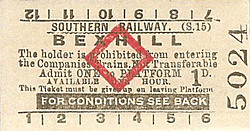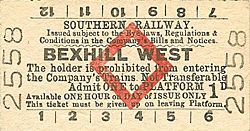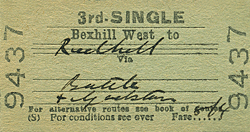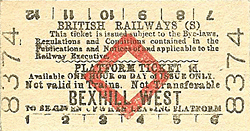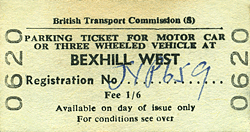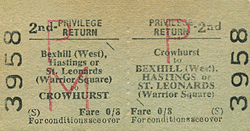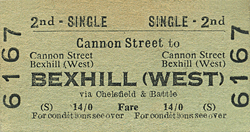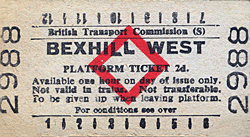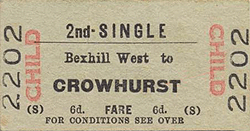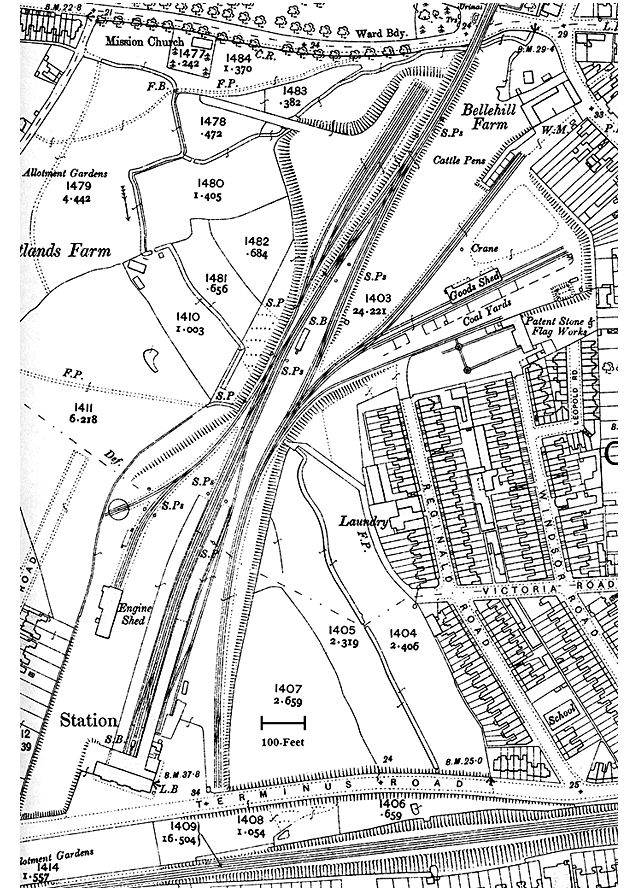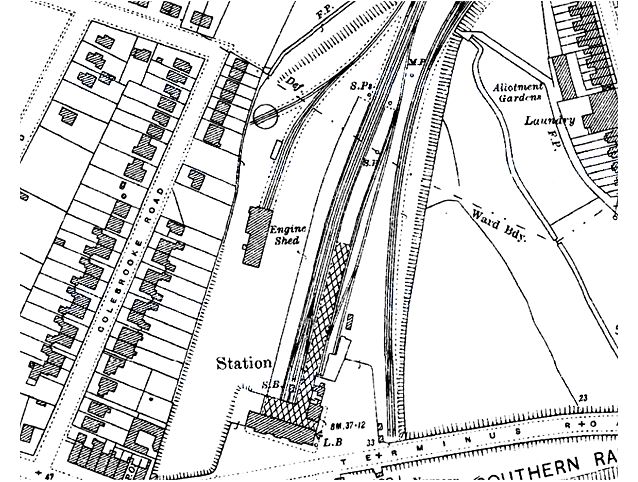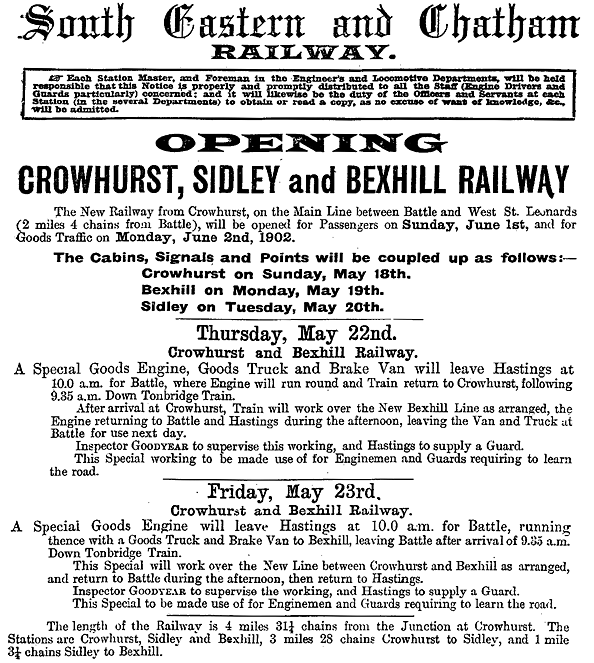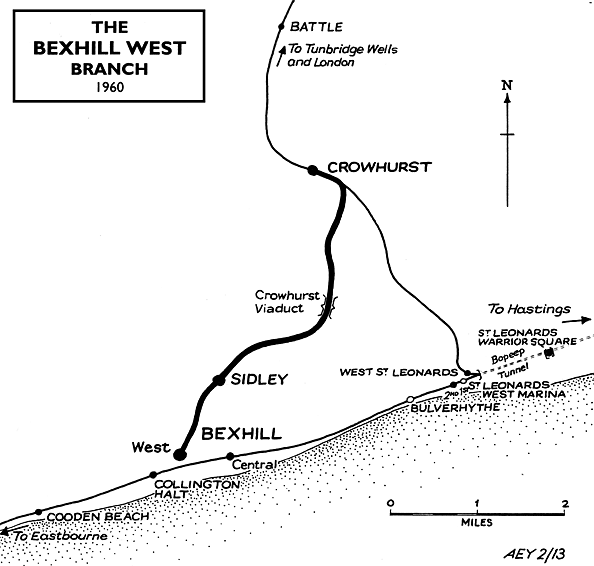Bexhill West Station was opened on 1st June, 1902, almost a fortnight after the Bexhill Speed Trials, held on May 19th. Located on the north side of Terminus Road, to the west of Beeching Road, it was opened by the Crowhurst, Sidley & Bexhill Railway Company.
Due to the report of Dr. Beeching to the, then, Government, it was completely closed on 15th June 1964, by British Railways (Southern Region). The platforms were demolished but the main station building still stands and was Grade II listed building by English Heritage, in February, 2013. The building (at the present time, 2016) houses an auction gallery, tea room and restaurant cum pub. The glass canopy of the station concourse also survives although a building was constructed under part of the canopy in the 1980s. The engine shed, to the north-west of the station, still stands, although it has been re-clad with corrugated metal sheeting and only the brick end walls are visible.
The station building, at Bexhill West, was approached by the newly-built Terminus Road, so named to distinguish it from Station Road which served the LB & SCR (London, Brighton and South Coast Railway Company) station. It was the largest and most imposing of the three station buildings designed by C S Barry & C E Mercer and reflected the SER’s (South Eastern Railway Company) ambitions for the line; the railway enthusiast and author, Gordon Biddle (in 1973) considered it to be excessively showy, and notes that it was too large for the traffic which never reached expectations. The frontage featured bright red brick with Bath Stone quoins, the high arched windows surrounded by pargetting, outbursts of swag and other terra-cotta moulding in the main gable. The centrally placed entrance included a block-moulded pediment which was carved in situ. The tall, steeply sloping roof was of red Welsh slates. The central section was hipped, but it was pitched over the lofty pavilions either side of the entrance – which carried fashionable mock Tudor timber stripes – and on the western and eastern ends of the frontage. A baroque clock turret was centrally placed on the roof, and it rose above a cupola-cum-ventilator over the waiting room behind. The main symmetrical building consisted of a large and lofty booking hall, ticket and parcels offices, a general waiting room which also included a ladies’ waiting room and toilet plus the stationmaster’s and inspector’s offices. A smaller block, which was placed at right angles to the main building and separated from it by an entrance onto the concourse, contained the refreshment room (let to Messrs Spiers & Pond Ltd), gents’ toilet, porters’ and lamp rooms. This building also had a cupola with an ogee-shaped metal dome.
There were two island platforms, 700ft in length and 30ft wide, of which the eastern one (platform 1 and 2) was covered with a glass canopy, carried on cast iron columns for a distance of 400 ft. The canopy was built to a standard design: virtually identical examples were in use at Addiscombe and London Bridge. A minor design difference was that the canopy valances at Bexhill did not feature the ‘clover’ patterned holes seen universally across the SE&CR network. The area covered by the canopy was paved while the exposed part of platform was gravelled. A vaulted-roofed concourse, 40ft by 90ft, lay between the station buildings and the platform and was covered in a similar manner to the eastern island platform. There was a run-round loop next to platform 1, whilst between platforms 2 and 3 there were three tracks, the centre one being an engine release track.
The western island platform which made up platform 3, and what would have been platform 4, was not covered, and platform 4 never actually received a track. It had a line of centrally placed lamp standards. After the early years, platform 3 was rarely used by passengers and was quickly covered by grass. Although the station buildings were lit by electricity, surprisingly the platforms were lit by gas and remained so until the line closed.
Signal box No.1 was 440 yards north of the platforms on the down side; it was 55 feet in length and of timber construction, on a brick base with a slated, pitched gabled roof. It controlled the extensive station yard and had 123 levers, 80 of which were used. There were generous goods facilities with numerous sidings, which made it useful for rolling stock storage later in life. At one time large hopper waggons from the Mountfield gypsum mine were stabled there but after closure of the branch these waggons were moved to a short length of track at the north end of the line. The goods yard ran along the eastern side of the station approaches, aligned at about 40 degrees to the running lines. It included a 140ft-long goods shed, which housed two 30 cwt cranes. A siding, parallel to the shed, served the coal depot coal. Two further long sidings ran to the north of the goods shed, roughly parallel with the running line, to serve a cattle dock and pens- these were sited close to the entrance to the yard, on Lower Street, for the convenience of farmers transporting livestock by rail. In the early days, the yard was very busy with large quantities of coal and timber traffic. There was sufficient work for one locomotive, stabled at Bexhill West, to be shunting in the yard all day.
Access to the yard required a reversal manoeuvre, which was made possible by a double-track headshunt (see note below), stretching the length of the station. On the western side of the running lines there were four carriage sidings on the up side opposite the goods yard; these were southward-facing and a reversal in the station was required to reach them. Finally, there was a two-road engine shed, also on the up side of the station. This measured 119ft by 32ft and was designed to house four tank engines. Of brick construction with a “northlight” roof, the shed was accompanied by a water tank and offices along its western side and a timber coal stage on the approach. In addition, engines that had reached the end of the line and needed to go back the wya they had come could be rotated on a 54ft 9in turntable. The engine shed was a sub-shed of Hastings until 1929 when it came under the control of St Leonards. In 1938, it was taken out of use and sold to Hall & Company who used it as a warehouse.
[Notes]
1 A ‘tank engine’ is a locomotive that carries water in tanks mounted on either side of the frame, which allows the engine to travel further than it would if it had to stop to refill with water.]
2 A ‘headshunt’ is a short length of track that allows a locomotive to uncouple from its train, move forward, and then run back past it on a parallel track. Such headshunts are typically installed at a terminal station to allow the locomotive of an arriving train to move to the opposite end of (in railway parlance, ‘run around’) its train, so that it can then haul the same train out of the station in the other direction (assuming, of course, that it is a locomotive equipped to run in either direction; for older, one-way equipment such as steam locomotives and cab unit locomotives, a wye or turntable needs to be provided to physically turn the engine around, as well as a run-around track).
The much smaller signal box, No.2, was, surprisingly, positioned between the buffer stop ends of platforms 2 and 3 and had 22 levers, of which 12 were in use; this box controlled the crossovers between these tracks.
Pullman kitchen cars were introduced onto the Tunbridge Wells line by the Southern Railway in 1926 and, for this, two gas cylinders were installed at the Bexhill terminus. These were sandwiched between the terminating platform lines and No.2 signal box and were used to refill the Pullman cars’ gas tanks.
During the 1950s, the station received green BR Southern Region running-in boards and larger station signs but it retained the Southern Railway ‘target’ signs on the lamp posts. BR totem signs were produced, but it appears that they were never installed.
Note! “Running-in boards”, also known as ‘Totems’, are the signs that you see as you arrive in a station – the ones that give the name of the station – as a matter of interest, these were removed on all stations during WW2 to make it difficult foe any spies dropped into the country.
The goods yard closed on 1st September 1963 with passenger closure coming on 15th June the following year. The entire track had been lifted by the summer of 1965, and the platforms were demolished in 1967 or early 1968 leaving just the roofed concourse and the main station building, which at this time housed the local Civil Defence training centre and headquarters.
The Civil Defence Corps vacated the site after the disbanding of Civil Defence in 1968. The building was listed as Grade II by English Heritage on 27 February 2013. English Heritage states that it is ‘perhaps the most impressive, surviving 1890s to 1914 public building in Bexhill’.
In the early 1980s the building was occupied by ‘Fryer’s Auction Galleries’. At this time a new building was constructed under the concourse for use as a store room by the gallery. Fryer’s was acquired by Gorringes Auction Galleries in 1994. They considered the building ideal for the auction gallery business. As well as the saleroom they also have a valuations office and long term storage facility on the former concourse. The canopy over the concourse is still intact and used as a loading dock for the auction house. The adjoining former refreshment rooms became a pub and restaurant called “West Station”. Externally there have been few alterations to the building other than a single-storey link block, between the main station and the former refreshment room, which is now the entrance to the pub. The engine shed survives; although it has lost its northlight roof with new cladding, the brick end wall remains as does the small brick building that formed the base of the water tank. The building is now a depot for a storage and removals business. The remainder of the good yard and carriage sidings are now occupied by the Beeching Road industrial estate.
BRIEF HISTORY OF THE BEXHILL WEST BRANCH
In 1844 the Brighton, Lewes & Hastings Railway obtained authority to build a line from Brighton to Hastings via Bexhill and, under the same Act, to sell the undertaking to the London & Brighton Railway. At that time, the Sussex seaside resort of Bexhill was still only a small fishing community on the coast while the village of Bexhill (now known as ‘Old Town’) stood on a hill about a mile inland. The first section of this line from Brighton to Lewes opened on 8th June 1846 while the section from Lewes through Bexhill to Bulverhythe, near St Leonards, opened on 27th June 1846. The London & Brighton Railway amalgamated with the London & Croydon Railway on 27th July 1846 to become the London Brighton & South Coast Railway (LB&SCR). A short extension from Bulverhythe to West Marina at St Leonards opened on 7th November 1846.
The LB&SCR opened a new line to Lewes from their main London to Brighton route, south of Wivelsfield at Keymer Junction, on 27 October 1847. This gave direct access to London from St Leonards, whilst a branch to Eastbourne was opened on 14 May 1849 from Polegate, which was about half way between Lewes and St Leonards.
An extension from St Leonards to Hastings, Rye and Ashford had also been sanctioned, although this was later transferred to the South Eastern Railway (SER) who built and opened the line through to Ashford on 13 February 1851. The SER also built a line from their main London to Dover route at Tonbridge to Hastings, via Tunbridge Wells and Battle, which opened on 1st February 1852 and gave direct access to London from Hastings. The LB&SCR line from West Marina at St Leonards joined the SER at a new junction called Bopeep.
__________________________________________________________________________________________________________________________________
Image 01 – The 1930 Ordnance Survey map, 1:2,500, clearly shows the glazed canopy over platform 1 and 2 and the concourse. There has been some residential development to the west of the station in Colebrooke Road.
Image 02 – The 1909 Ordnance Survey map (1:2,500) on the left shows the extensive facilities that were provided at Bexhill West. Platform 1 and 2 are seen on the right, with 3 and 4 to the left. Platform 4 is shown devoid of track and it is unlikely this platform ever did have track. The canopy over platform 1 and 2 and the concourse is not shown although it was present from the opening of the station. No. 2 signal box is seen between the two platforms; this controlled the crossovers between the platforms. The two-road engine shed is shown to the west of platform 4 with the coal stage on the approach line to the shed just south of the turntable. Nearer the top of the map four carriage sidings are seen on the up side. The unnecessarily large No. 1 signal box is shown between the running line and the goods yard just above the centre. The goods yard comprised four long sidings. Two were roughly parallel to the running lines, serving a cattle dock and pens near to the yard entrance on Lower Street. A weighbridge (WM) is shown just inside the entrance. To the south and at 40° to the running lines one siding passed through the goods shed while a parallel siding served the coal depot. To the south a fifth siding served the Patent Stone and Flag Works which has two additional short sidings with wagon turntables. Two additional sidings are seen to the east of the platforms terminating close to the road.
____________________________________________________________________________________________________________________________________
At this time, despite having a railway station, Bexhill had still not developed into a seaside resort, unlike its neighbours Eastbourne and Hastings. Towards the latter part of the nineteenth century, prompted by the 8th Earl De La Warr, who was a major landowner in the area, it was decided to try and develop Bexhill into one of the leading health resorts in the south of England. One slight disadvantage was the absence of a more direct rail route to London. Passengers considered it inconvenient that they either had to take the LB&SCR route via Lewes, or change at Hastings and travel on the SER line via Tonbridge.
The ill-fated Ouse Valley line, which the LB&SCR had planned in 1863, to run from their main London to Brighton line north of Hayward’s Heath to Uckfield, with extensions to Hailsham and Bexhill, would have no doubt given a quicker route to the capital but, unfortunately, even though construction had started, the LB&SCR ran into financial problems and the line was abandoned. At about the same time, a branch to Bexhill from the main SER line just south of Battle had also been proposed but never materialised.
With Earl De La Warr’s plans to develop the area really starting to have an effect in the 1880s, a Bexhill Direct Railway from Battle was proposed in 1884 and, again, in 1885 with access to Eastbourne, but still nothing came of these plans or similar plans in 1889. In 1896 the nominally independent Crowhurst, Sidley & Bexhill Railway (CS&BR) was promoted by local landowners and businessmen including Earl De La Warr.
This consortium in addition to other subscribers put money up to build a line from the SER London and Hastings line south of Battle near the small village of Crowhurst, where a new station would be built, and from where the new line would leave the main SER line and run across the valley and marshes to Sidley and terminate at Bexhill; a length of 4½ miles. This new line had the full backing of the SER who were prepared to advance the CS&BR a substantial loan to get things moving and agreed to work the line using SER rolling stock. The authorised capital was £135,000 with borrowing power of £45,000 on mortgage; although this seemed a large amount of money for such a short line, it must be pointed out that a 17-arch viaduct was needed to cross the marshes, while deep cuttings south of Crowhurst and at Sidley were also required.
The Royal Assent for the construction of the line was obtained on 15th July 1897. The company appointed Arthur John Barry of Westminster (London) and Percy Crosland Tempest (Chief Engineer of the SER) as their joint engineers. The contract to build the line was given to John Price of Westminster, whose firm later became Price & Reeves while the line was under construction.
With such a heavily engineered line 700 navvies were engaged, and most of them were provided with living accommodation in special wooden dwellings at Crowhurst. Some preliminary work of ground clearing was done in the latter part of 1897 and construction started in January 1898. With construction of the CS&BR taking place at the Crowhurst end of the line, steps were taken to complete the compulsory purchase of land at Bexhill as authorised by the Act of Parliament. At this time, it was at the height of the Bexhill land boom and the CS&BR had to pay heavily. With all of this extra expense involved, the company was further authorised to borrow £48,000 under an Act of 1st July 1898, plus £16,000 on mortgage.
The most difficult and time-consuming feature was the 17-arch Crowhurst Viaduct which spanned the valley and marshes for a length of 417 yards. It caused the contractors a great deal of trouble on several occasions owing to the subsidence of the embankments at either end. The north abutment was started in December 1898, and the last arch was turned on 21st September 1900. Originally it was intended to construct the piers on piles driven into the earth, and a start was made, but the piles gave way. It was then decided to substitute huge concrete blocks, forming a stable foundation.
There were two deep cuttings on the route: the first one was at Crowhurst, where 280,000 cubic yards of earth were removed and used to form embankments in the vicinity. The other deep cutting was at Sidley, where 300,000 cubic yards of earth were excavated from the site where the station and goods yard were built. The earth was taken from here to Bexhill to form the banks and foundations for the new line and terminus. There were 16 bridges on the route which included three over public roads, in addition to iron footbridges at Crowhurst and Sidley stations and one near Worsham Manor. The three station buildings, particularly the terminus at Bexhill, were rather grand for such a short line. The joint architects were C S Barry and C E Mercer.
On 1st January 1899, the SER finally ended many feuding years with their rivals the London Chatham & Dover Railway (LC&DR) by entering into an agreement whereby both companies would remain separate but would work together under the heading of the South Eastern & Chatham Railway Management Committee (SE&CR).
The twin-track line was inspected by Major J W Pringle on behalf of the Board of Trade on 25th April 1902. Major Pringle submitted his report three days later and, with only minor improvements suggested, he authorised the opening of the branch for passenger traffic. It was announced that the new line would be officially opened on Saturday 31st May 1902 with passenger services starting the following day.
On the day of the grand ceremonial opening, the three stations were lavishly decorated with bunting and flags. A special train packed with local dignitaries was scheduled to leave at noon to travel to Crowhurst Junction to meet the directors and guests arriving from London Bridge at 12.30. The carriages carrying the directors, invited guests and members of the London press were coupled to the Bexhill train for the return journey which was made at slow enough rate to give the guests an idea of the character of the construction of the new line.
Hundreds of local people gathered at the terminus, on a glorious day, to watch the arrival of the train. Speeches on the platform followed and, after an inspection of the station premises, the guests adjourned to the nearby Hotel Metropole for a grand banquet. Large tables were laid in the booking hall for a luncheon for the station staff and other railway employees.
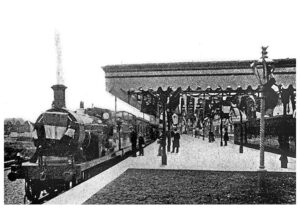 Flags decorate the station as the first train pulls out of Bexhill West for Crowhurst on 1 June 1902.
Flags decorate the station as the first train pulls out of Bexhill West for Crowhurst on 1 June 1902.
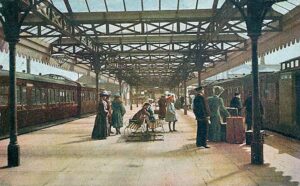
A number of well dressed ladies prepare to board a train at Bexhill West. This is an official picture published in 1905, but it probably shows the station shortly after opening in 1902.
The public service started the following day. The distance from London to Bexhill by the South-Eastern & Chatham route was only 62 miles compared with 71 miles by the London, Brighton & South Coast Railway. The initial service was generous with thirteen down and thirteen up trains on week days; of these, one up and one down were through express services to Charing Cross and Cannon Street, stopping only at Tunbridge Wells, Sidley, and Bexhill – the total journey time from Cannon Street being 1 hour 39 minutes. In addition to the through expresses there were four up and three down trains with through carriages; of these, one down and two up were to Charing Cross, the other two, both up and down, were to Victoria. There was also a good Sunday service.
Despite the optimistic beginnings with the quicker route to London, many passengers still seemed to favour the LB & SCR station and the original route. The South Eastern Railway absorbed the Crowhurst, Sidley and Bexhill Railway Company in 1905. Matters were not helped during the First World War when a directive from the Railway Executive Committee, requested that the branch (like many other branch lines) be closed as an economy measure and all services were withdrawn from 1st January 1917. Although goods trains started to operate again from 5th November 1917, full passenger services were not reinstated to Bexhill until 1st March 1919 while Sidley surprisingly remained closed to passengers until 14th June 1920. To try and tempt passengers back, ‘through trains’ to London were quickly restored.
Under the SE&CR, services were worked by the older classes of SER locomotives, which were stationed at Bexhill. These continued until 1936, when push-pull trains were introduced. Under British Railways, push-pull services were operated by H Class 0-4-4T locomotives. Through services between Bexhill and Charing Cross were worked by Schools Class 4-4-0 locomotives; these were withdrawn at the beginning of the Second World War and never reinstated.
[Note! Under the classification of steam locomotives, 0-4-4 represents a wheel arrangement where there are five axles – at the front the leading axle, with two wheels that do not provide any power to the locomotive (this is represented by the ‘0’). This axle is followed by two other axles, carrying four powered and coupled driving wheels (represented by the second ‘4’). There are then four more trailing wheels, on two more axles, which is represented by the ‘4’. The ‘T’, again, tells us that it was a ‘tank’ engine.
For those interested in learning more about this system of classification, it was thought of by a Frederick Methvan Whyte, and came into use in the early twentieth century.
After the 1923 grouping, the SE&CR became part of the newly formed Southern Railway who, by inheriting the former LB&SCR and SE&CR stations, found itself with two stations at Bexhill. To confuse matters the SE&CR station had been opened as Bexhill-on-Sea even though the LB&SCR station was actually nearer to the sea. To overcome this matter the former LB&SCR station was named Bexhill Central from 9 July 1923 while the former SE&CR station became simply Bexhill until it received its final name of Bexhill West in November 1929.
Although some through trains to London had been reintroduced, the Southern Railway arranged that most main line trains calling at Crowhurst would include three corridor carriages for Bexhill West; however this failed to attract passengers away from the former LB&SCR route where, even though the journey was longer, they could still reach London without changing.
In 1930 planning consultants Messrs Adams, Thompson and Fry were asked by the Town Council to produce a report on the general development of Bexhill. What they proposed was to connect the two railway lines by building a loop from the head of the West station goods yard crossing over Terminus Road and joining the Central station line near Sackville Arch. The consultants also suggested a new Central station on the goods yard at Buckhurst Place with a station entrance fronting on to the Town Hall Square. Nothing came of this plan.
In 1935 the former LB&SCR coastal line was electrified and, from then on, the Southern Railway seemed to have considered it as their main London line from Bexhill while the former CS&BR line from Bexhill West was seen more as a branch.
In 1937 the Southern Railway proposed a scheme for electrification of the main Hastings line and this also included the Bexhill West branch. Special stock was to be provided to fit the main line’s restricted loading gauge. Unlike the former LB&SCR line this scheme came to nothing, but if it had been carried out it might have given the branch a long-term future.
From the late 1930s, pull-and-push trains started working the line and replacing some of the through carriages. By the mid 1940s they took over completely when the through carriages were withdrawn.
After Nationalisation in 1948, the Southern Railway passed into the hands of the British Railways Southern Region. In 1949 the line, which was now very much referred to as a branch, briefly assumed the full importance of a main line when Bopeep Tunnel, on the main line, had to be closed for extensive repairs. The work lasted from 27th November 1949 until 4th June 1950, which necessitated all main line trains from London to Hastings terminating at Bexhill West. The little used platform 3, at Bexhill West, was brought back into service at this time.
Once the tunnel was repaired and normal service was resumed, the pull-and-push trains again were restored to a routine timetable. In October 1950 there were 15 down trains on Monday-to-Friday with 16 on Saturday and nine on Sunday. There were 16 up trains on Monday-to-Saturday and eight on Sunday. This arrangement lasted until June 1958 when steam trains gave way to two-car DEMUs which connected with the London to Hastings diesel-electric trains at Crowhurst. At this time a new timetable was introduced with an hourly service. Even then, steam briefly returned to the branch in March 1959 owing to a shortage of diesel stock. Also, during this time, an unadvertised school train ran between Etchingham and Bexhill West. It is claimed that the timetables were altered to the disadvantage of those commuters who wished to use the line; fares were also raised, adding a further disincentive to travel on the branch.
[Note! “DEMU” stands for “diesel-electric multiple unit”. A multiple unit is basically a coach (carriage) that carries people but is powered by its own on-board diesel engines, which turn electrical generators that, then, drive the coach via electrical motors. The “multiple” refers to the fact that each coach is designed to be driven by itself, from either end, or coupled with other similar coaches, and the complete “train” then driven from any coach within the train. This saves reversing and/or de-coupling when a coach is needed to go the other way.]
The Sunday winter service was withdrawn from 3rd January to 10th April 1960, and was never re-instated. From this time onwards fears grew for the future of the line and when the “Beeching Report” was published on 27th March 1963, the Bexhill West branch was one of the lines recommended for closure. On 8th June 1963 the formal proposal of closure to passengers was published, projecting a withdrawal date of 9th September 1963, if no objections were received; as it happened, goods services ceased on that date. A better service from St Leonards was promised in addition to a bus service to connect Bexhill West and Sidley stations.
With over 200 season ticket holders making regular use of the line from Bexhill West, and about 40 from Sidley, it is not surprising that they formed the basis of the opposition to the closure and quickly formed the Hastings, Bexhill & District Season Ticket Holders’ Association. An inquiry was soon held by the Transport Users’ Consultative Committee for the South Eastern Area at Bexhill Town Hall, where a petition of 1,000 names was handed in. With a warning of hardship, which would cost regular travellers at least five extra hours per week in travel, there was a delay in effecting closure, but. on 22nd April 1964. Ernest Marples, Secretary of State for Transport, upheld the decision to close the line with a new closure date of 14th June 1964.
The last train from Bexhill West to Crowhurst was packed when it left at 10.20 pm on Sunday 13th June; two passengers on the last train had actually made the first journey in 1902.
After the line closed there were several attempts to have it re-opened, but all to no avail. The track was lifted in 1965 and that also included the bays and fast through tracks at Crowhurst. The bridge, which crossed over Little Common and Down roads, was demolished in 1967 and, then, in May 1969, with great publicity, Crowhurst Viaduct was dramatically blown up, with a large crowd gathering on the Crowhurst marshes to witness the event.
Some of the route can be walked at the north end of the branch. In 2009 East Sussex County Council proposed building a new link road between Bexhill and Hastings, which would form a 3½ mile road from its junction with the A259, in Bexhill, to a junction with the B2092, Queensway in Hastings. Part of the proposed route would use the trackbed of the Bexhill branch from a point just north of the Glover’s Farm overbridge, through the station site at Sidley to a junction with the A259 (King Offa Way). Despite a vigorous campaign to stop the road, which has been described by many people as the “road to nowhere”, work on it started in January 2013, and the Department for Transport announced final funding approval in April 2013.
Between the A259 and the Bexhill West terminus, the trackbed is occupied by the aptly named Beeching Road Industrial Estate. Another section of the trackbed, between Sidley and Crowhurst, is likely to be lost due to the building of the Combe Valley (formerly Pebsham) Countryside Park.


